Do You Want To Discover Future Disruptive Innovations? Explore Obscure Journals!
In my previous blog entitled “How Obscure Journals Help Researchers Who Want To Innovate”, I set out to make the case that great innovations, and by that I mean those technological breakthroughs that eventually will change your and my life, are first published in obscure journals. The idea was that researchers who are really resolved to innovate, and not merely tinkering with existing technologies to make nice but insignificant improvements, ought to explore and navigate what is being published in obscure journals. It was pointed out that the challenge in doing so is that this kind of journal is in shockingly short supply in most research and academic libraries for a variety of reasons. The main problem was that nobody gets paid or rewarded or praised more for researching obscure journals.
In this article, I will share compelling data that goes to show that some of today’s most influential technologies were first published in obscure journals years ago when nobody believed in them. Technologies such as WiFi, Blockchain, Cloud Computing, and Cybersecurity illustrate a common pattern. At the onset, when they were insufficiently understood and not widespread, their main venue of publication was obscure journals. Later, as the scientific community alighted on them and their popularity waxed they were embraced by traditional well-known commercial journals. Obviously, that would have been late for the innovating researcher because the technology would be old news already.
The diffusion of innovations: the social journey from “I don’t care about it” to “I have to have it now”
Professor Everett M. Rogers was an eminent American sociologist who originated the diffusion of innovations theory and coined the term “Early Adopter”. The first edition of his classic book “Diffusion of Innovations” was published in 1962. Ever since his theory of how innovations spread and reach critical mass has been widely accepted worldwide. Essentially, he posited that the diffusion of innovations is a social process that follows a predictable path. When a new product or service is first created, most people won’t pay attention to it. A small crop of individuals who are passionate about trying new stuff will first pick it up. They are at times referred to as the geeks. They help out in identifying weaknesses in the new product so that a more workable product can be created. Then, a second group comes along: the early adopters. They want to find something that works and that can assist them in furthering a productivity goal so that they can pull ahead of the pack. These latter become evangelists of the new product and go about convincing others. Thereafter, once product benefits are proven and sufficiently known, a much larger group joins the fray: the early majority. At this moment the product picks up steam and is being adopted in masses. The early majority are crowds who are inspired by the early adopters. Subsequently, the product social acceptance continues to grow and eventually, the rest of the market embraces it. It is a social process that takes years in most cases, as it requires behavioral changes. The figure below depicts the social journey of diffusion of innovations:
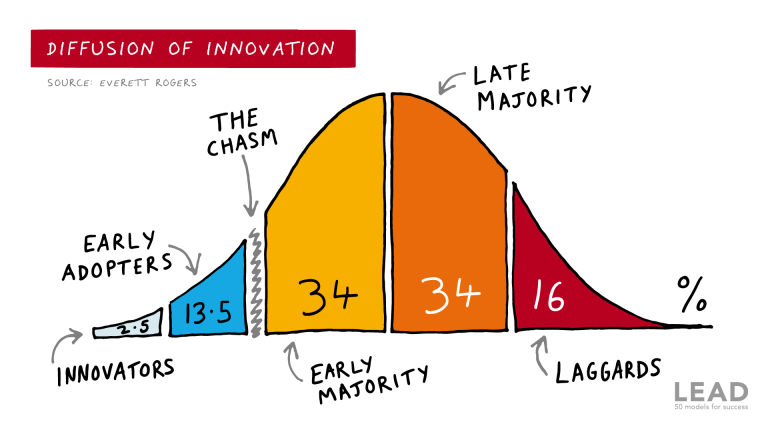
The diffusion of innovation in academic publishing:
The social journey from obscure journals to mainstream journals…
Today Wi-Fi is everywhere you go: at work, at home, on the beach, etc. Even on public transportation, you find that people can hook up their laptops and smartphones to local wireless networks while they enjoy the ride. In fact, we can’t think of a place without Wi-Fi. But this wasn’t the case 20 years ago when telecom giants were investing billions of dollars trying to develop it. Indeed, while the vision of wireless Internet was bold and big at the turn of the year 2000, the early applications fell through. They didn’t live up to the hype. At one time, most experts in telecom technologies doubted the mere viability of Wi-Fi and many just pulled out of it to cut their losses. As time passed by, researchers discovered new ways to improve it until they made it good enough. In the year 2001 only relatively unknown obscure journals were brave to publish the few papers available on the nascent Wi-Fi. Remember that back then, it was not a massively popular topic in the scientific community, and as a result, it wasn’t good business for the mainstream journals that need to publish stuff appealing to large audiences. In those days, Wi-Fi was a niche field that remained unproven. Definitely, it was not a priority.
Now, assume it is the year 2000 and you are the kind of researcher who wants to know what new and potentially revolutionary technologies are being cooked up so that you can be part of the next wave. What can you do? If you look into what is published in high impact factor mainstream journals you won’t find much there, and you will miss the boat. By definition, high impact factor journals are more frequently cited than others, and researchers tend to cite what is already popular or a hot topic of interest to majorities. Obscure journals are specialized and smaller in volume terms, and they publish content based on its relevance rather than its popularity or “hotness”.
Newer, futuristic, innovative and unproven knowledge is likely to be published in obscure journals before everywhere else…
It is a fact that mainstream high impact factors are generally inclined towards publishing research papers that have broad readership appeal and that can be proven to be correct and accurate. After all, their reputation and prestige depend on it. The papers they publish have to have good enough historical and empirical data to prove their points. Furthermore, experts in the field who stamp their “seal of approval” vet these papers. That works well for incremental innovations, but it falls through the cracks for disruptive innovations. The former supports the current mental paradigms because it is based on making gradual improvements on something that already exists (see my previous article if this point is not clear). The latter, on the other hand, essentially defies the prevailing mental paradigms, they appeal to those researchers and scientists who think different, and more importantly, want to change the rules of the game.
The chart below is a case in point. It depicts how in the very early days of Wi-Fi the vast majority of research papers on the subject were published in obscure journals. It was years later, once the broader scientific community picked up interest in it, that mainstream high impact factor journals started to publish about it. Researchers who were curious enough to step outside the box, and looked into obscure and specialized journals had a head start over those that stay doggedly focused on reading a few highly popular journals.
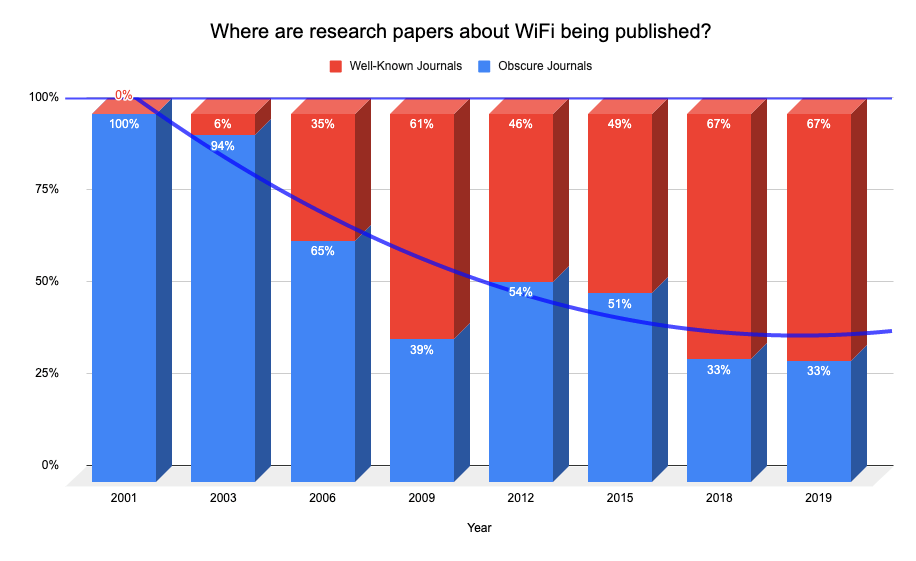
The pattern observed with the diffusion of innovative information about Wi-Fi in academic publishing is also seen in other technologies that have changed our lives. Take a look at the following charts for Blockchain, Cloud Computing, and Cybersecurity. It is the same story: at the outset, when the technology is nascent, unproven, and unpopular obscure journals represent the main venue for innovative and forward-thinking researchers to share their work. Later on, once the early majority of the scientific community has “socially accepted”, mainstream high impact journals take over.
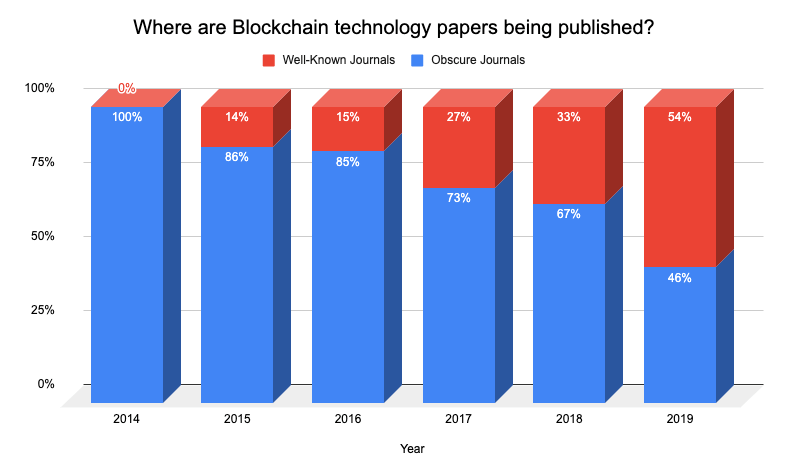
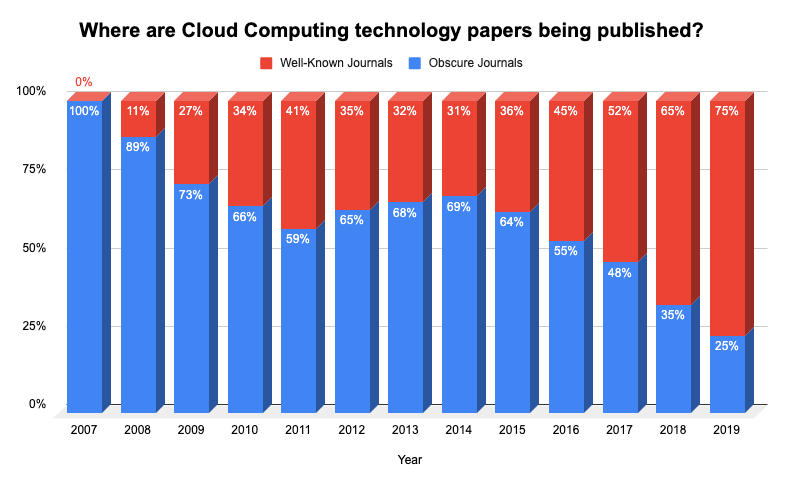
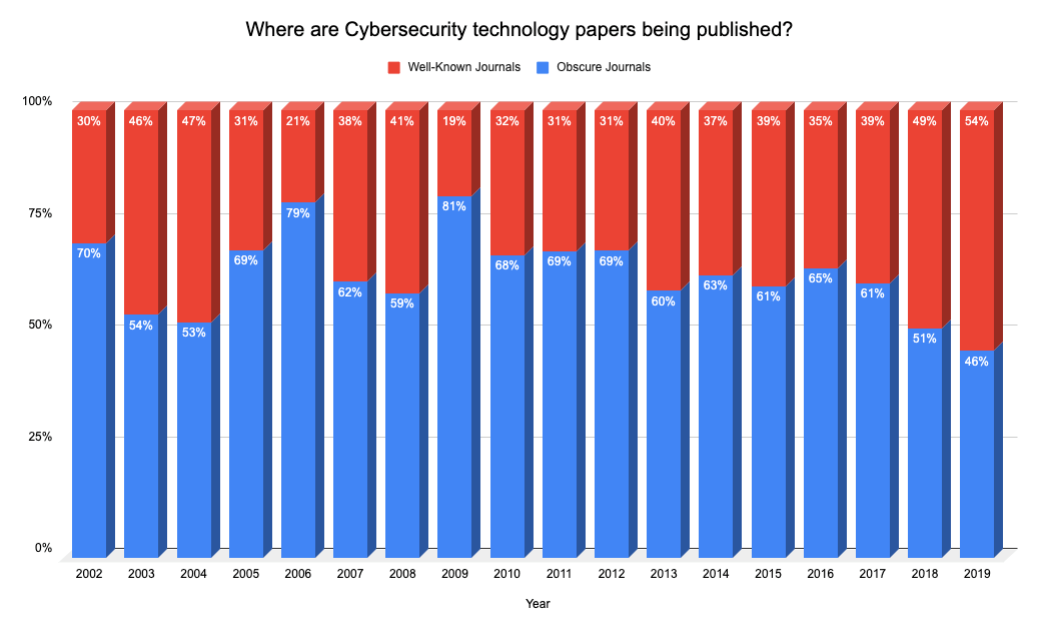
Why aren’t obscure journals more readily available to researchers if they are so useful to support innovative research?
If you check the various discovery platforms that are made available to researchers in libraries or on the web, they all have one thing in common: high visibility of highly cited papers and high impact journals. That is it. If you don’t believe me, run a quick check yourself. It is like the only papers that matter is those published by the top commercial publishers in the world. If a big shot publisher does not publish a journal or a paper, it won’t stand a chance to cut it into the library. Why is this?
Most people in the research and library community are sorely unaware of how information about future disruptive innovations is disseminated. Everyone takes for granted that if new knowledge is not published in a high impact factor journal, it is junk. Most librarians belittle the role of obscure journals. The reverse is true; they stay away from them because they lack the highly coveted high impact factor. Researchers are incognizant of the major role obscure journals may play in their efforts to unearth future innovations.
In addition to lack of awareness, obscure journals are rarely used because neither librarians nor researchers are rewarded to use them. Let me clarify this. Researchers are praised when they publish in highly cited journals and largely ignored when they don’t. But as we saw before, truly disruptive innovations seldom qualify to be published in mainstream journals until they are widely accepted by early majorities. Librarians strive to bring quality content to the library and repel the rest, and since obscure journals don’t command the golden proxy for quality (impact factor), they are spurned and berated.
It is my hope that this article serves the purpose of enlightening researchers and librarians alike about the huge importance for those scientists who are bold enough to think big to try to change the world!
What is the most comprehensive source of discovery of obscure journals that I know?
I have studied a wide swath of journal articles discovery platforms available to the scientific communities including those free on the web such as Google Scholar, Semantic Scholar, DOAJ, arXiv, Bielefeld Academic Search Engine, ResearchGate, MedLine, etc. As well as the leading classic subscription-based such as Scopus, Web of Science, EBSCO, Summon, etc. In all of them, most of the indexed and easily visible journal titles or articles stem from the leading commercial publishers. Google Scholar seems to have the largest coverage, but unfortunately, it ranks highly cited articles over and above everything else. As a result, articles published in obscure journals are unlikely to make it to the first pages, which is what everybody checks before turning away.
In my opinion, J-Gate is by far the most complete source of research journals in the world. As far as I’m aware of, it is the only journal articles discovery platform in the world indexing nearly 55,000 journals at the article level. And each journal is indexed from beginning to end. This has resulted in 65,000,000 journal articles. It covers all the mainstream high impact factor journals as well as the obscure, more specialized, little known journals that I referred to in this article. What I like the most about it, it’s that it ranks articles and journals based on relevance rather than citations. This, in turn, gives equal chance to articles from anywhere provided that they are relevant.
J-Gate has another unique feature that undoubtedly fosters research of future disruptive innovations: personalization of journal research. A researcher can create a search environment where only his favorite journals are researched and anything that comes from other journals will not clutter his work. The potential of this feature is enormous. For instance, a researcher may choose to only research journals with the word “Computer” in the title. This will enable her to research articles that come from “Computer” journals only. That will incorporate well-known as well as obscure journals mixed together based on relevance. Try to do this on any other platform and let me know…
For those of you who may think that the foregoing is the same as filtering by subject in a traditional discovery engine, let me clarify that it is not. Filtering by subject occurs at the article level whilst journal personalization occurs at the journal level, which is a level higher up. The latter enables a much more focused and contextualized search on a specific field than the former. As an outcome, obscure journals have a better chance to surface with less effort.
Till the next article on the quest for innovation…
Walter Kny
CEO & Founder
InnoLibrary Global

 Next Post
Next Post